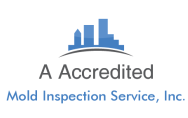 New Construction Mold Inspections
New Construction Mold Inspections

Mold hidden behind fiberglass insulation in a massive bank we inspected in the Florida Panhandle. The building was still under construction when a hurricane hit the building and caused mold in all the perimeter walls.
At A Accredited Mold Inspection Service we do mold inspections and mold testing on new construction and existing buildings.
It is quite common for moisture to enter a new home or building during construction. Moisture enters new construction projects when storms occur during construction. If a storm occurs prior to roofs, windows, doors, or caulking being completed, then leaks occur.
Sometimes building defects such as flashing defects on the roof or window caulking defects can cause moisture and mold problems. New construction mold inspections are intended to find such issues.
Three of our largest mold inspections involved commercial buildings or residential complexes under construction.
On the below examples we conducted new construction mold inspections to help the contractors and owners understand, document, and resolve the mold problems.
New Construction Mold Problems Example 1
One was of a condo development in the Florida Keys. During renovations most or all windows leaked during and after window replacement. In addition, the roof was replaced, and leaks occurred. Several dozen condos were inspected by us and mold was found in all the units.
New Construction Mold Problems Example 2
At a separate condo complex in the Key West the builder appeared to not have done anything wrong. All the completed work that his sub-contractors completed seemed to be watertight. However, approximately 50 condos sustained water damage and as a result they became extremely moldy. If the builder did nothing that was obviously wrong, then why did they become wet and moldy you may ask? The answer is Hurricane Irma. The new construction was about 95% done when the hurricane hit and caused water to enter incomplete roofing components. It is difficult enough for a fully constructed waterfront condo building to withstand hurricanes. But when the building is not complete disaster is hard to avoid. All but two of the condos were water damaged and severely moldy by the time I inspected them.
New Construction Mold Problems Example 3
A third large mold inspection on a new building involved a 50,000 square foot bank that was under construction, in the Florida Panhandle. The builder did not put cap stones and other water deflecting components on the roof. Delivery of the materials were delayed because of a recent hurricane. When a second hurricane hit weeks later, water poured in. I found that 100% of all the perimeter walls were covered with thick growths of Stachybotrys or Toxic Black mold. All the moldy drywall was very well hidden behind fiberglass batt insulation. The moldy perimeter wall drywall was also behind metal wall studs. The moldy drywall could not be removed without also removing the metal studs that made up the perimeter walls structure.
Oftentimes there is no gross negligence, no defects. Instead, rainstorms or hurricane occur before the building is water tight.
New Construction Mold Inspection Example 4
New construction mold problems also affect homes. I did a mold inspection of a newly constructed home in Port St Lucie. Many trusses in the attic were very moldy. It was obvious that the trusses were left outside in the rain and mud for extended periods of time during construction. This is common, and a little such mold in the attic is not unusual and ok in my opinion. However, this case was extreme. I documented the problem in my report. The builder rectified the problem by having a professional mold remediation company clean the attic and replace the insulation.
Photos From Mold Testing and Inspections at New Construction.
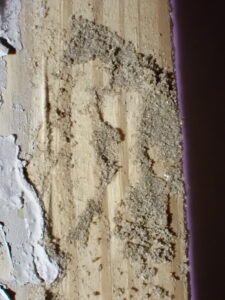
Mud on a wooden 2×4. It looks like subterranean termite tunnels, but it is not. This is mud resulting from this 2×4 attic truss being laid in the mud during construction. On the left we see concrete resulting from it being laid in wet concrete during construction. This was found during a new construction mold inspection.
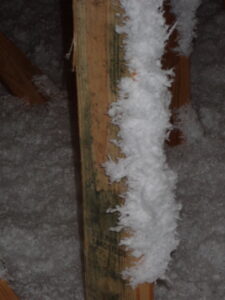
On the left side of this 2×4 attic truss we see mold. On the right side we see fluffy white fiberglass insulation. This is the result of the truss being laid on wet muddy ground during construction. A little of this type of mold issue in attic is common and acceptable. But this attic in Port St Lucie Florida was full of this type of mold problem in dozens of locations.
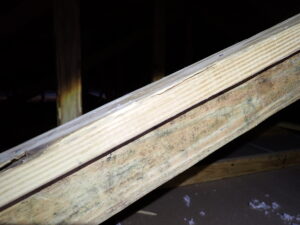
Another section of a moldy 2×4 truss in the same moldy attic. A little of this type of mold issue in attic is common and acceptable. But this attic in Port St Lucie Florida was full of this type of mold problem in dozens of locations.
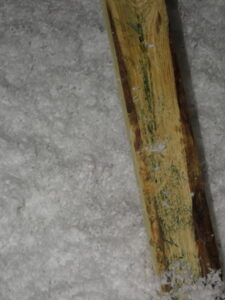
Another section of a moldy 2×4 truss in the same moldy attic. In the background we see lots of fluffy white blown in fiberglass insulation.
Mold Testing in New
Buildings And Your Contractor
You may think that a reputable contractor is aware of the potential for health threatening mold. You may feel that because of a fear or liability, your contractor will do the right thing. Even if your contractor is knowledgeable and honest, and looking out for your best interest your he cannot be everywhere all the time. Often leaks occur during construction. In such cases, day laborers or even skilled sub-contractors may be the only ones to witness the water intrusion. Some laborers or sub-contractors or even general contractors may feel it is just a distraction.
They may quickly patch up a leak and paint over water damage leaving moisture and mold inside your walls to grow. When considering the above scenarios, it becomes apparent that mold testing in new construction can be very beneficial. Testing for mold in an unfinished building can often help find problems that may have otherwise gone un-discovered.
 A Accredited Mold Inspection Service We specialize in accurate, objective mold inspections for new and existing homes and buildings. We do not remove mold. We only inspect mold, so we have no conflict of interest. Our only goal is to do the most accurate and thorough mold test and inspection at the best possible price for our clients.
A Accredited Mold Inspection Service We specialize in accurate, objective mold inspections for new and existing homes and buildings. We do not remove mold. We only inspect mold, so we have no conflict of interest. Our only goal is to do the most accurate and thorough mold test and inspection at the best possible price for our clients.
Call Us If You Need Us. 1-888-381-6651.

